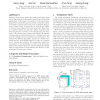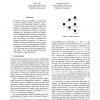KDD
2004
ACM
14 years 9 months ago
2004
ACM
Clustering algorithms typically operate on a feature vector representation of the data and find clusters that are compact with respect to an assumed (dis)similarity measure betwee...
KDD
2004
ACM
14 years 9 months ago
2004
ACM
In this paper, we describe the development of a fielded application for detecting malicious executables in the wild. We gathered 1971 benign and 1651 malicious executables and enc...
KDD
2004
ACM
14 years 9 months ago
2004
ACM
Detection of near duplicate documents is an important problem in many data mining and information filtering applications. When faced with massive quantities of data, traditional d...
KDD
2004
ACM
14 years 9 months ago
2004
ACM
Most data mining algorithms require the setting of many input parameters. Two main dangers of working with parameter-laden algorithms are the following. First, incorrect settings ...
KDD
2004
ACM
14 years 9 months ago
2004
ACM
Privacy-preserving data mining has concentrated on obtaining valid results when the input data is private. An extreme example is Secure Multiparty Computation-based methods, where...
KDD
2004
ACM
14 years 9 months ago
2004
ACM
The primary goal of Web usage mining is the discovery of patterns in the navigational behavior of Web users. Standard approaches, such as clustering of user sessions and discoveri...
KDD
2004
ACM
14 years 9 months ago
2004
ACM
Extensive studies have shown that mining microarray data sets is important in bioinformatics research and biomedical applications. In this paper, we explore a novel type of genesa...
KDD
2004
ACM
14 years 9 months ago
2004
ACM
Procedures for collective inference make simultaneous statistical judgments about the same variables for a set of related data instances. For example, collective inference could b...
KDD
2004
ACM
14 years 9 months ago
2004
ACM
Existing data mining algorithms on graphs look for nodes satisfying specific properties, such as specific notions of structural similarity or specific measures of link-based impor...
KDD
2004
ACM
14 years 9 months ago
2004
ACM
The paper presents a method for pruning frequent itemsets based on background knowledge represented by a Bayesian network. The interestingness of an itemset is defined as the abso...



